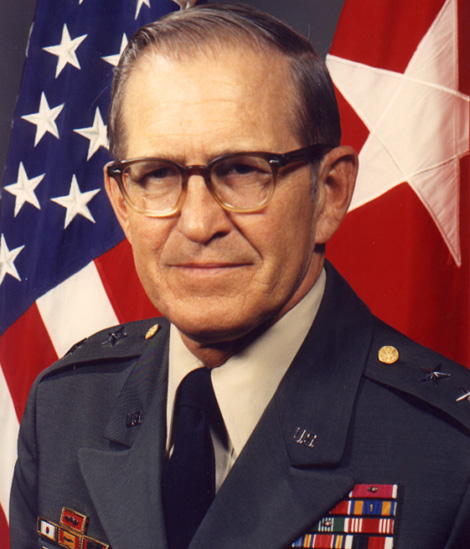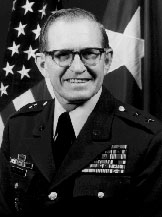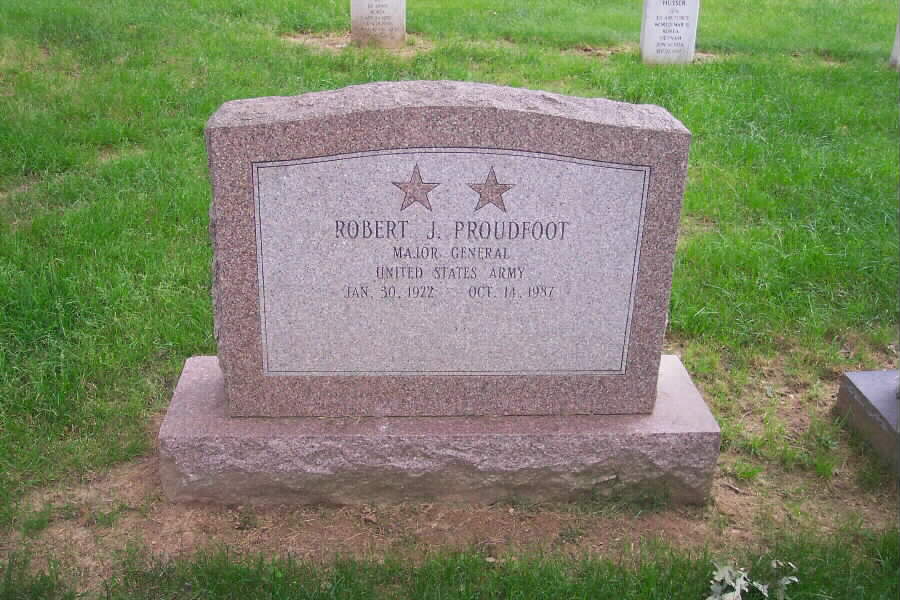Major General Robert J. Proudfoot, the 12th Commander of White Sands Proving Ground/Missile Range was born in Philippi, West Virginia, on 30 January 1922 and received his formal education in Clarksburg, West Virginia. He was granted his BS Degree from the University of Maryland in 1958, and received a Master of Business Administration Degree from Babson Institute in 1962. In addition to the course at the Industrial College, he has completed courses at the Command and General Staff College, the Ordnance School, and the Ordnance Guided Missile School.
He enlisted in the Army soon after the outbreak of World War II and received a commission as a Second Lieutenant in the Ordnance Corps in October 1943. He remained at Aberdeen Proving Ground, Maryland, during the remainder of the war years, and in September 1946 was released from active duty.
General Proudfoot was recalled in 1948 and was assigned to Camp Loeper Ammunition Depot in the Far East. He spent three years on that tour, first in Japan and later in Korea. Soon after return to the States, he entered the missile field and attended the Guided Missile Officer Course. Subsequently, he served as a Guided Missile Project Officer at HQ Second Army and later with the Southern European Task Force (SETAF) in Italy.
Returning to the States once more in 1961, he attended the Command and General Staff College and enrolled at Babson Institute for his graduate studies. After obtaining his Master of Business Administration Degree, he was assigned to HQ USARPAC in Hawaii as a Special Weapons and Guided Missile Officer. In 1965 he moved to the 25th Infantry Division at Schofield Barracks and accompanied the Division to Vietnam in 1966. After a year in Southeast Asia he was assigned to the Army Materiel Command in Washington as Deputy Project Manager, Practice 9. He left that position in August 1967 to attend the Industrial College of the Armed Forces and upon completion in June 1968 was assigned to the US Army Missile Command, Redstone Arsenal, Alabama, as Project Manager, Shillelagh Weapon System and served in this capacity until June 1971. In June 1971, General Proudfoot was reassigned as Project Manager of the Lance Weapon System, US Army Materiel Command, Washington, DC, with duty at Redstone Arsenal, Alabama.
On 7 March 1973, General Proudfoot was assigned to the Office of the Assistant Secretary of the Army (Installations and Logistics) as the Deputy for Materiel Acquisition. He assumed command of White Sands Missile Range in July 1974.
As the 12th commander of the largest all-land national test range in the United States, General Proudfoot was responsible for nearly 8,000 military and civilian personnel, a budget of almost $150 million and for operations on and over some 8,000 square miles of land in New Mexico and Utah.
General Proudfoot is married to the former Miss Lois Eastman of Elmira, New York, and the couple are the parents of a son and a daughter. During his military career, he has been awarded the Legion of Merit and the Air Medal with Oak Leaf Cluster, for service with the 25th Infantry Division in Vietnam, the Bronze Star, for heroism while assigned to the Tenth Corps in Korea, and the US Army Commendation Medal.
General Proudfoot died on 14 Oct 1987.
Courtesy of the United States Army
Major General Robert J. Proudfoot was born in Philippi, West Virginia in 1922 and enlisted in the Army in 1942. He attended Ordnance Officer Candidate School at Aberdeen Proving Ground late in 1943 and subsequently served in a variety of assignments in the U.S., Korea, and the Pacific.
General Proudfoot was a graduate of the University of Maryland and later earned a Master of Business Administration at Babson Institute. Late in 1950, as Depot Officer for the 69th Ordnance Ammunition Company in Hungnam, Korea, he was instrumental in the successful evacuation of nearly 9,000 tons of ammunition in less than a week in the face of an enemy advance. The operation was accomplished owing to his extraordinary initiative, aggressiveness, and planning ability.
In the mid-1960s, he was responsible for the successful programming of all munitions and missiles required in support of all Army elements in the Pacific Theater. Sent to Vietnam to deal with an urgent munitions logistics project, he developed within a few days a munitions control and supply system which normally would have taken the Logistics Command several weeks to organize.
As Project Manager for the Shillelagh and later the Lance Missile systems, he oversaw the inclusion of these two major weapons systems into the Army inventory between 1968 and 1973. He subsequently directed the $3 billion Army Materiel Acquisition Program, and then culminated his nearly 33-year career with the command of the White Sands Missile Range in New Mexico from 1974 to 1975. Among his other accomplishments was the planning for the High Energy Laser Test Facility.
General Proudfoot retired from the Army in 1975 and died in 1987. He was buried with full military honors in Section 30 of Arlington National Cemetery.
Michael Robert Patterson was born in Arlington and is the son of a former officer of the US Army. So it was no wonder that sooner or later his interests drew him to American history and especially to American military history. Many of his articles can be found on renowned portals like the New York Times, Washingtonpost or Wikipedia.
Reviewed by: Michael Howard



